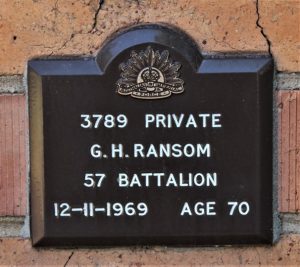Cr George Henry Ransom

Cr George Henry Ransom
George Henry Ransom was born in 1899 in Wongong, Western Australia, to parents Robert Thomas Frederick Ransom and Maude Mary Ransom (nee Nichols). Wongong is now classified as a semi-rural south-eastern suburb of Perth, but in 1899 it would certainly been a rural setting. The Ransom family were from Mildura, Victoria and they returned there shortly after George’s birth, so it is not certain as to the purpose of them being in this area of Australia at that time. George was the third of eight children, born to the couple, and spent the first 29 years of his life living in Mildura, except for time spent overseas serving in the army during World War 1.
Private George Henry Ransom served with the 57th Battalion, enlisting in Melbourne on 16 November 1917, and returning to Australia on 19 April 1919. The 57th saw great action during this time on the Western Front, being involved in battles along the Hindenburg Line, as well as in Bullecourt, Polygon Wood, Ypres, Viller-Bretonneux and St Quentin Canal. In late September 1918, Ransom suffered a gunshot wound to his right arm and right leg. He was treated in the field and then evacuated back to England for further treatment and rehabilitation, it was here that he saw out the remainder of the war. In early 1919, he returned to Australia for further convalescence before being discharged.
By 1920, Ransom ultimately returned to his family in Mildura and went back to his work as a horticulturist. Following his discharge from the army, George applied for a WWI Soldier Land Settlement, for a property in Red Cliffs, just south of Mildura, where he intended to grow fruit. In the late 1920’s he had given up this career took his skills to the Melbourne suburb of Northcote, working as a horticulturist. This was around 1930 and just prior to the depression years.
In 1938, George Henry Ransom married Ada Jane Beckwith (1892-1955). They were both working at the munitions factory within Maribyrnong, which is where they likely met. They continued to work at munitions factory right through the period of World War 2. The couple moved to Altona in the mid-1940s, and Henry Ransom quickly engrossed himself into local affairs. His first attempt to enter local politics occurred in 1951 at the election to fill John Grant’s vacancy for the Altona Riding of the Werribee Shire council. The independent Eric William Ward, a line foreman with the State Electricity Commission, easily outpolled Ransom as the endorsed Labor candidate. While voters did not have a personal bias against Ransom, many residents were repelled by the pressure tactics of his group, the Altona Ratepayers’ Association. This association had been formed in early 1951 by Labor activists.
At the Werribee council elections in 1954, Ransom was this time successful in the polls and served for the final three years of the Altona Riding, alongside councilors Harry Kim and Reg Logan. In 1957 when Altona seceded from Werribee, Ransom was elected to the new Altona Shire council. George Ransom was the second elected candidate, behind Reg Logan, and it was favoured that Reg would become the first Shire President but at the first council meeting George Ransom was elected and served in this role for the next ten weeks until further council elections were held in August 1957. He served a further two years until the election in 1959 when he retired at the age of 60.
George saw his wife pass away in 1955 and continued living in Maidstone Street until his own death in November 1969 whilst being treated at the Heidelberg Repatriation Hospital. George Henry Ransom is interred within the Fawkner Memorial Park. His wife, Ada Jane Ransom (nee Beckwith), is also interred within the Fawkner Memorial Park.

Grave at Fawkner Memorial Park
